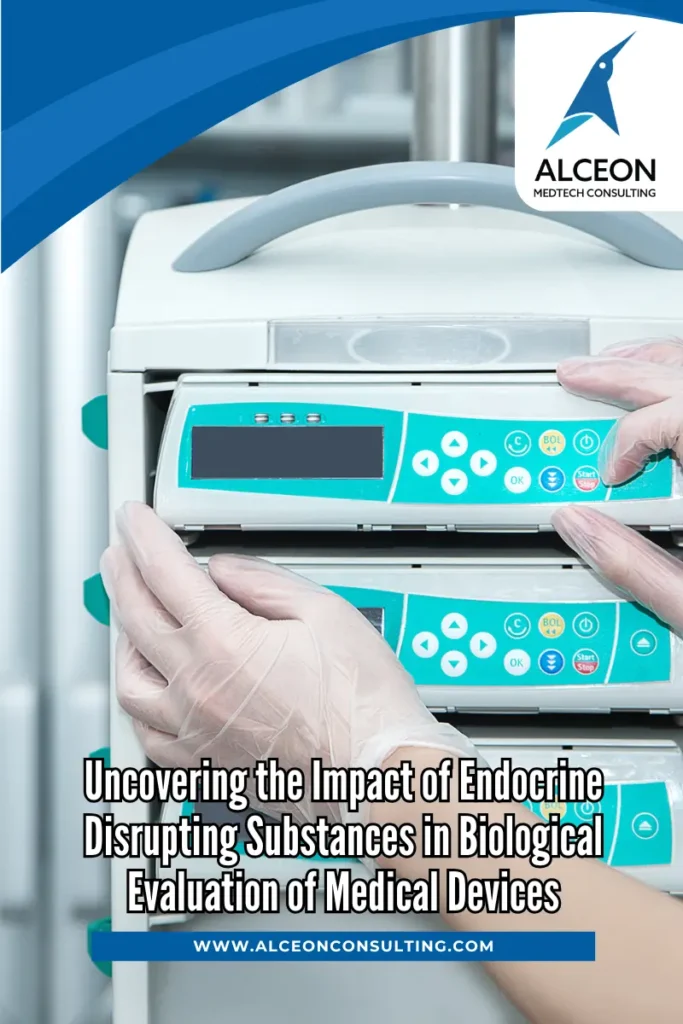In recent years, there has been growing concern about the presence of endocrine-disrupting substances (EDS) in various products, including medical devices. EDS are chemicals that can interfere with the normal functioning of the endocrine system, which plays a critical role in regulating hormonal balance in the body. This blog delves into the significance of considering EDS in the biological evaluation of medical devices and highlights the importance of thorough testing and assessment.
Understanding Endocrine Disrupting Substances
Endocrine-disrupting substances can mimic or block the actions of natural hormones, leading to adverse effects on human health. These substances can be found in plastics, metals, adhesives, lubricants, and other components used in medical devices. Given the potential for these substances to leach or migrate from the device into the body, their presence raises concerns about potential disruption of the endocrine system.

According to the Endocrine Society, there are nearly 85,000 human-made chemicals in the world, and 1,000 or more of those could be endocrine disruptors, based on their unique properties. The following are among the most common and well-studied
- Phthalates are a large group of compounds used as liquid plasticisers. They are found in hundreds of products, including some food packaging, cosmetics, fragrances, children’s toys, and medical device tubing. Cosmetics that may contain phthalates include nail polish, hair spray, aftershave lotion, cleanser, and shampoo.
- Atrazine is one of the most commonly applied herbicides in the world, often used to control weeds in corn, sorghum, and sugarcane crops.
- Bisphenol A (BPA) is used to make polycarbonate plastics and epoxy resins. It is used in manufacturing, food packaging, toys, and other applications. BPA resins may be found in the lining of some canned foods and beverages.
- Dioxins are a by-product of certain manufacturing processes, such as herbicide production and paper bleaching. They can be released into the air from waste burning and wildfires.
- Perchlorate is a colourless salt manufactured and used as an industrial chemical to make rockets, explosives, and fireworks, which can be found in some groundwater.
- Per- and polyfluoroalkyl substances (PFAS) are a large group of chemicals used widely in industrial applications, such as firefighting foam, non-stick pans, paper, and textile coatings.
- Phytooestrogens are naturally occurring substances with hormone-like activity found in some plants; they may have a similar effect to oestrogen produced by the body. Soy foods, for example, contain phytoestrogens.
- Polybrominated diphenyl ethers (PBDE) are used to make flame retardants for products such as furniture foam and carpet.
- Polychlorinated biphenyls (PCBs) were used to make electrical equipment, such as transformers, and are in hydraulic fluids, heat transfer fluids, lubricants, and plasticisers. PCBs were mass-produced globally until they were banned in 1979.
- Triclosan is an ingredient that was previously added to some antimicrobial and personal care products, like liquid body wash and soaps.
Regulatory Framework
Recognising the importance of addressing EDS in medical devices, regulatory bodies have developed guidelines and standards. For instance, the International Organisation for Standardisation (ISO) has published ISO 10993-18, which provides guidance on the assessment of EDS in medical devices. Additionally, the U.S. Food and Drug Administration (FDA) requires manufacturers to evaluate the potential for EDS in their devices during the pre-market approval process.

The above guidelines are intended to be used for a BRA of the presence of phthalates in certain medical devices covering phthalates that are carcinogenic, mutagenic, toxic to reproduction (CMR) or have endocrine-disrupting (ED) properties. The Guidelines can be used for the justification of the use of CMR/ED phthalates in a medical device according to the Regulation (EU) 2017/745 on medical devices. They also provide a framework on how to assess and compare possible alternative substances, materials, designs, or medical treatments to the use of CMR/ED phthalates in medical devices. Major aspects include the functionality of phthalates, the performance of the medical device using the phthalate or the potentially relevant alternative for the phthalate, as well as the risk assessment of the phthalate or the alternatives. In the end, the benefit(s) shall be weighed against the possible risks of the use of the CMR/ED phthalate and of the alternative substance, materials, designs, or medical treatments. This overall analysis will determine whether it is justified or not to use a CMR/ED phthalate in a medical device

Biological Evaluation and Risk Assessment
Biological evaluation of medical devices involves a comprehensive assessment of their potential risks to human health. This includes evaluating the potential for EDS by analysing the materials used, conducting chemical characterisation, and assessing the potential for leaching or migration. Various testing methods, such as in vitro assays and in vivo studies, are employed to evaluate the presence and effects of EDS.
In Vitro Testing: In vitro testing involves exposing cells or tissue cultures to extracts of the medical device to assess the potential for EDS-induced disruptions. These tests can help determine if the device components release EDS that may interfere with hormonal pathways.
In Vivo Testing: In vivo testing, typically performed on animal models, further examines the effects of EDS. These studies examine the systemic effects resulting from exposure to the device or its extracts. Evaluating parameters such as endocrine organ weights, hormone levels, and histopathological analysis can provide valuable insights into the presence and impact of EDS.

The presence of EDS in medical devices necessitates a risk-based approach to ensure patient safety. Manufacturers should employ suitable strategies to mitigate the potential risks associated with EDS, including using alternative materials, optimising device design, and implementing suitable manufacturing processes.
Considering the potential impact of endocrine-disrupting substances on the human body, their assessment during the biological evaluation of medical devices is of utmost importance. Understanding and addressing the presence of EDS is essential to safeguarding patient health and well-being. Through rigorous testing and risk assessment, manufacturers and regulatory bodies can ensure the development and use of safe and effective medical devices in healthcare settings.
We at Alceon Medtech Consulting can help you draft your biological Evaluation Plans and Reports. Reach us for your needs.

